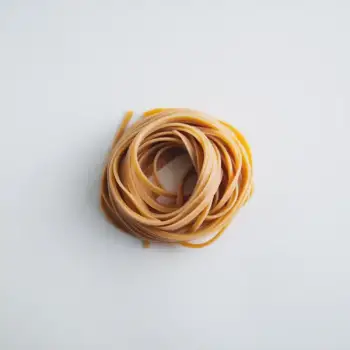Tagliatelle and Fettuccine are both flat, ribbon-like pasta types, with tagliatelle being wider with a rough texture, and fettuccine being narrower and smoother, affecting how they hold different sauces in cooking.

Tagliatelle is a traditional pasta from the Emilia-Romagna and Marche regions of Italy. Known for its flat, ribbon-like shape, tagliatelle has a slightly rough texture that helps it to beautifully cling to sauces.

Fettuccine is a type of pasta popular in Roman and Tuscan cuisine. Similar to tagliatelle, it is also a flat, ribbon-shaped noodle but is generally narrower in width and has a smoother texture.
While both pastas share a similar appearance, tagliatelle is typically wider and has a rougher surface compared to fettuccine's narrower and smoother ribbons. This difference in texture affects how each pasta interacts with sauces and ingredients.

Your ultimate Recipe Box, Meal Planner, and Cooking Class all in one
Tagliatelle is traditionally served with meaty sauces such as Bolognese. Its wider ribbons and rough texture make it ideal for holding onto hearty, chunky sauces. Fettuccine, while it can also be paired with meat sauces, offers a different experience with its smoother surface. Fettuccine is famously paired with Alfredo sauce, creating the classic Fettuccine Alfredo. Its smooth texture complements the silky cream sauce. Tagliatelle can also be used with cream sauces, but expect a slightly heartier bite. Both pastas can be enjoyed with seafood. Tagliatelle pairs well with thicker seafood sauces, allowing the chunks of seafood to cling to the pasta, whereas fettuccine is better suited for lighter, oil-based seafood sauces. Tagliatelle with a mushroom ragù or a simple tomato and basil sauce brings out the earthy flavors, while fettuccine complements lighter vegetable sauces, such as those with a lemon butter base.
Both Tagliatelle and Fettuccine are similar in nutritional value, providing a good source of carbohydrates and protein. However, the exact nutritional content can vary based on whether they are made with eggs or different types of flour.
| Nutrient | Fettuccine ( per 100g serving ) | Tagliatelle ( per 100g serving ) |
|---|---|---|
| Fat | 1.2g | 1.5g |
| Fiber | 2.7g | 2.5g |
| Sodium | 4mg | 16mg |
| Protein | 9g | 10g |
| Calories | 267 | 271 |
| Carbohydrates | 53g | 54g |
Yes, you can substitute fettuccine for tagliatelle in Bolognese sauce, but the sauce may not cling as well to the smoother, narrower fettuccine as it does to the rougher, wider tagliatelle.
Nutritionally, tagliatelle and fettuccine are very similar. The choice between them should be based on texture preference and the type of sauce you are using.
Yes, the width and texture of the pasta can impact how it holds sauce and the overall mouthfeel of the dish. Wider, rougher pastas like tagliatelle are better suited for thick sauces, while smoother pastas like fettuccine pair well with lighter sauces.
They can be used interchangeably; however, consider the sauce type. Tagliatelle is better with thicker, chunkier sauces, while fettuccine is preferable for lighter, delicate sauces.
Both pastas should be cooked in a large pot of salted boiling water until al dente, usually for about 7-10 minutes, depending on the thickness. Always taste test a few seconds before the lower end of the recommended cooking time.